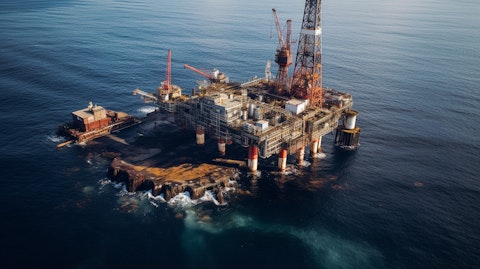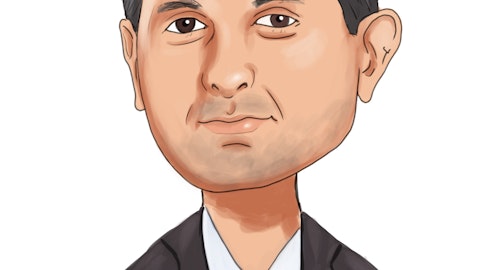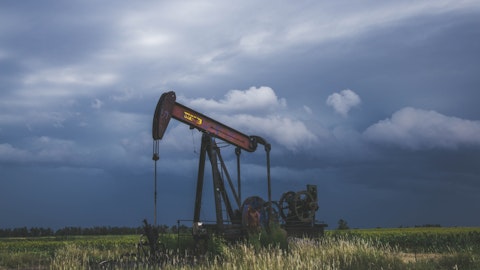KLX Energy Services Holdings, Inc. (NASDAQ:KLXE) Q3 2023 Earnings Call Transcript November 7, 2023
KLX Energy Services Holdings, Inc. beats earnings expectations. Reported EPS is $0.47, expectations were $0.38.
Operator: Greetings, and welcome to the KLX Energy Services Third Quarter Earnings Conference Call. At this time, all participants are in a listen-only mode. A brief question-and-answer session will follow the formal presentation. [Operator Instructions] As a reminder, this conference is being recorded. It is now my pleasure to introduce your host, Ken Dennard. Thank you. You may begin.
Ken Dennard: Thank you, operator, and good morning, everyone. We appreciate you joining us for the KLX Energy Services conference call and webcast to review third quarter 2023 results. With me today are Chris Baker, KLX Energy’s President and Chief Executive Officer; and Keefer Lehner, Executive Vice President and Chief Financial Officer. Following my remarks, management will provide a high-level commentary on the financial details of the third quarter and talk about its outlook before opening the call for your questions. There will be a replay of today’s call, and that will be available by webcast on the company’s website at klx.com. There’ll also be a telephonic recorded replay available until November 21, 2023. More information on our access to these replay features was included in yesterday’s earnings release.
Please note that information reported on this call speaks only as of today, November 7, 2023, and therefore, you’re advised that time-sensitive information may no longer be accurate as of the time of any replay listening or transcript reading. Also, comments on this call will contain forward-looking statements within the meaning of the United States federal securities laws. These forward-looking statements reflect the current views of KLX management. However, various risks and uncertainties and contingencies could cause actual results, performance or achievements to differ materially from those expressed in the statements made by management. The listener or reader is encouraged to read the annual report on Form 10-K, quarterly reports on Form 10-Q and current reports on Form 8-K to understand certain of those risks, uncertainties and contingencies.
The comments today will also include certain non-GAAP financial measures. Additional details and reconciliations to the most directly comparable GAAP financial measures are included in the quarterly press release, which can also be found on the KLX Energy website. And now with that behind me, I’d like to turn the call over to KLX Energy Services President and CEO, Mr. Chris Baker. Chris?
Christopher Baker: Thank you, Ken, and good morning, everyone. Last night, we released our Q3 earnings, and we are extremely pleased with our third quarter performance. KLX maintained margins and generated incremental free cash flow despite a sequential 10% decline in rig count, a 7% decline in frac spread count and continued prolonged weakness in natural gas basins. As we report Q3, it appears the rig count is trying to bottom and natural gas prices have rebounded considerably which bodes well for future activity levels, including incremental gas directed activity into 2024. I’ll go through the highlights of our third quarter before turning the call over to Keefer to discuss our financials in detail. KLX continues to focus on driving utilization and defending price to maximize margins and free cash flow.
Our operations team has done a fantastic job all year adjusting their cost structures and maintaining pricing discipline. Overall, KLX continues to leverage its geographic and product service line diversification to drive results. Our more than 2,000 team members are well positioned across all major U.S. onshore basins to deliver our comprehensive portfolio of differentiated services and proprietary products. We believe the quality of our team and services allows us to capture a larger share of customer spending with outsized exposure to the largest, most active and best capitalized operators in the U.S. onshore market. For the third quarter, we had a revenue mix that was balanced both on a geographic and product mix basis. Geographically, the business was extremely balanced in Q3 with the Rockies generating 35% of revenue, up from 28% in Q2.
The Southwest represented 35% of revenue, down slightly from 37% in Q2 and Northeast/Mid-Con represented 30% of Q3 revenue, down from 35% in Q2. We saw outsized contribution from the Rockies in Q3, driven by our market-leading position and our ability to rotate additional assets and crews to the basin given the softness in our other markets. Q3 is typically the most active quarter in the Rockies given the lack of seasonality. We were able to drive utilization and pricing within the basin and the sequential increase in both revenue and adjusted EBITDA was driven by an improvement across the vast majority of our in-basin product service offering though it was led by rentals, coiled tubing and directional drilling. From a product line perspective, completions focused activity was responsible for 51% of Q3 revenue, production and intervention was 25% and drilling was 24%.
Consistent with reductions in rig count and frac spread count, we saw sequential activity declines across most of our PSL but by and large, the decline was less volatile than the underlying change in those industry metrics. We view these results as a testament to the quality of KLX’s products and services. From a pricing perspective, it was a bit of a mixed bag as we experienced modest low to mid-single-digit percentage pricing declines in some of the more competitive completion-oriented service lines but this was largely offset by other service lines where we were able to maintain or, in some cases, increase pricing. The combination of our efforts to maximize utilization, protect price and control costs, coupled with a 6% sequential reduction in head count, led to a very strong quarter despite the reduction in market activity.
We reported solid Q3 numbers all within or slightly above previously provided guidance. Revenue came in within our guidance range of $221 million, and we reported 17% adjusted EBITDA margin which is consistent with Q2 and above the top of our prior guidance range, which led to an adjusted EBITDA coming in at the very top of our implied prior guidance range at $36.7 million. Further, our year-to-date nine-month and LTM performance are both all-time company records. Our strategy of diversification has driven strong and relatively consistent performance despite the underlying market volatility. We generated $12.6 million in free cash flow during the quarter, enabling us to meaningfully increase our reported cash position to $90.4 million which is up $49 million year-over-year.
We reduced net debt 4% sequentially to $194 million yielding a 1.3x net leverage ratio for both Q3 annualized and LTM as of Q3 2023, after generating an all-time high trailing 12-month adjusted EBITDA of $152 million. Q3’s performance highlighted the strength of KLX’s diversification strategy and demonstrated KLX’s ability to generate strong free cash flow in a challenging market. The recent frenzy of consolidation on the upstream side of the market cements our view that U.S. oil and gas production has strong long-term fundamentals. We also view consolidation of the larger operators as an opportunity for KLX to provide our differentiated integrated offering to a smaller number of larger customers. We continue to push the envelope on our R&D efforts and have recently launched and commercialized additional proprietary products.
In Q3, we launched our new line of KLX vision completion tools. This includes the new KLX phantom dissolvable plug where we experienced a 500-plus percent sequential increase in units sold and sold more plugs in Q3 than we did in the prior 4 quarters combined. Our latest generation plug has seen rapid market adoption across multiple basins with leading operators. Additionally, we also commercialized a patent-pending proprietary extended reach tool, the KLX Oracle SRT. Oracle SRT, short for Smart Reach technology is a true game changer in smart downhole drill out tools and is clearly synergistic with our coiled tubing and through tubing offerings. The tool delivers cutting-edge performance while also enabling safer operations. By the end of this week, we will have logged over 1 million downhole running fee with the Oracle SRT.
These advancements will drive efficiencies and differentiated performance for our customers, which will in turn drive utilization and margins for KLX. With that, I’ll now turn the call over to Keefer who will review our financial results, and I will return later in the call to discuss our outlook in greater detail. Keefer?
Keefer Lehner: Thanks, Chris. Good morning, everyone. As Chris mentioned, we reported quarterly revenue of $221 million, representing a 6% sequential decrease, which is lower than the 10% sequential decline in rig count. For comparison purposes, we reported third quarter 2022 revenue of $222 million, which was down only 50 basis points, which compared to the 20% year-over-year decline in rig count is a testament to the strength of our diversification strategy. The Rockies and Southwest segments each contributed 35% of Q3 revenue, led in the Rockies by our rentals, coiled tubing and tech services product service lines and in the Southwest, by directional drilling, rentals and coiled tubing. The Northeast and Mid-Con contributed 30%, led by pressure pumping, directional drilling and accommodations.

Consolidated adjusted EBITDA was $36.7 million, demonstrating our ability to successfully maximize utilization, defend price and manage costs despite the much discussed rig count decline. Adjusted operating income for the third quarter was $17 million. Total SG&A expense for Q3 was $18.6 million. When you back out the nonrecurring cost, adjusted SG&A expense for Q3 would have been only $17.5 million or just 7.9% of quarterly revenue. We continue to run with one of the leanest overhead structures in the sector for diversified business and believe we can scale further while continuing to drive down G&A expense as a percentage of revenue. Q3 net income and diluted earnings per share were $7.6 million and $0.47, respectively. Adjusted net income and adjusted diluted EPS were $8.2 million and $0.51, respectively.
Turning now to a review of our segment results. I’ll begin with the Rockies. The Rocky Mountains segment third quarter revenue was $77 million, representing a 16% sequential increase and a 16% increase over the prior year quarter. Sequential increase in revenue was attributable to increased revenue across most product service lines, but led by coiled tubing, rentals and directional drilling, where we experienced favorable Q3 seasonality and improved utilization as well as maintained or increased pricing. The Rockies experienced a strong increase in profitability. Adjusted operating income for the third quarter was $17.7 million. Adjusted EBITDA was $23.3 million compared to second quarter adjusted EBITDA of $17 million and 35% higher than $17.3 million in the prior year quarter.
The sequential increase in profitability was driven by reduced white space and an increase in contribution from our higher-margin services throughout the DJ, Wyoming and Bakken led by coiled tubing, rentals and pressure pumping. Moving now to our Southwest segment. The Southwest experienced a 14% year-over-year increase in revenue, generating revenue of $77.8 million in Q3. The year-over-year revenue increase was driven by the Q1 2023 acquisition of Greene’s, which has been a major success for KLX. The sequential decline in revenue was driven by lower pricing and utilization across our drilling and completion product lines. Q3 adjusted operating income for the Southwest segment was approximately $5 million and adjusted EBITDA was $11.8 million.
As a reminder, the Greene’s business is now fully integrated within our Southwest segment with Q3 being the second quarter of full revenue and margin contribution. We have also successfully actioned $3 million of annualized cost synergies. Northeast Mid-Con Q3 revenue was $65.8 million, a 24% decrease relative to Q2 driven largely by reduced activity and modestly reduced pricing in our frac business, where we continue to run 2 spreads, pumping 17% fewer stages in Q3 compared to Q2. And lower pricing and utilization across our broader drilling and completion service lines, driven by the market disruption in the gassier areas within this segment. Segment adjusted operating income for the third quarter was just over $5 million, and adjusted EBITDA was $11.4 million for the quarter.
At corporate, our adjusted operating income and adjusted EBITDA losses for Q3 were $10.9 million and $9.8 million, respectively. The corporate adjusted EBITDA loss improved by 3% sequentially and 17% compared to Q3 2022, demonstrating our ability to layer in acquisitions and realize significant economies of scale. This is a core tenet of our M&A thesis and we have seen the dramatic benefits play out over the last few deals. I’ll now turn to our net working capital, cash flow and capitalization. Our third quarter 2023 cash balance was $90.4 million, up 10% from $82.1 million in Q2. The sequential increase in cash was largely driven by our ability to efficiently convert adjusted EBITDA to free cash flow. Net working capital was approximately $85 million as of Q3.
We reduced net debt 4% sequentially, ending the quarter with a net debt balance of $193.7 million. Based on annualized Q3 and LTM results, we have a net leverage ratio of just 1.3x. We ended the third quarter with roughly $155 million in liquidity consisting of $90.4 million of cash and availability of $64.4 million under our September 2023 ABL borrowing base certificates. We did not issue shares under our ATM in Q3 and have not issued any shares to date in 2023. Also of note, Archer Limited announced last week that they exited their roughly 900,000 share position in KLX as part of their refinancing, thereby materially reducing any overhang in KLX shares. Our share count remains at 16.4 million shares. Now turning to CapEx. Capital expenditures for the third quarter were approximately $17.8 million and were primarily focused on maintenance spending across our various segments.
Going forward, we maintained total CapEx guidance for 2023 to be in the range of $45 million to $55 million, but currently expect to come in at the top end of that range. This spend will be primarily focused on maintenance spending with approximately 80% supporting ongoing operations and the remaining CapEx earmarked for reactivation and growth focused on quick payback projects across our rentals, frac rentals, directional drilling and wireline business, amongst others. As always, we continuously review CapEx levels and drivers to identify current trends or determine inefficiencies based on prevailing market conditions. During Q3, we sold approximately $5 million in assets. At the end of the third quarter, we still had $2.3 million of assets held for sale reflected on our balance sheet.
As we look to the remainder of 2023 and begin to think about 2024, our focus remains on maximizing free cash flow and further reducing net debt all while being prudent stewards of capital as we pursue additional value-creating M&A. I’ll now turn the call back to Chris, who will provide some additional color on the current market as well as our current outlook.
Christopher Baker: Thanks, Keefer. Before we wrap up, I’d like to share some additional details on our outlook and strategy. We expect a bit of slowdown in Q4 due to seasonality and budget exhaustion, but we believe the market activity is trying to find the bottom. As we look to 2024, we are confident the KLX platform is as well positioned as ever to ultimately benefit from increased customer activity and consolidation. Whether due to our lean cost structure, additional asset capacity or deployment of cutting-edge technology, the KLX platform has material intrinsic upside even in a moderately increasing market. As we enter the fourth quarter, we’ve seen consolidated rig count decrease an incremental 9% compared to a Q3 average of 649 rigs.
WTI price is currently in the low 80s which is flat with the Q3 average and approximately 10% below quarter end, while natural gas price hovers around a very constructive $3.30. Our public customers have been incredibly disciplined regarding growing production and have leveraged the tremendous operating efficiencies afforded to them by their service providers to their benefit but ultimately, the strength of underlying commodity prices should drive strong returns for our customers and in return, additional service activity relative to Q3 2023 levels. Consistent with prior guidance, we expect full-year 2023 adjusted EBITDA to be in the range of $140 million to $150 million and expect that the business will continue to perform well due to our focus on crew utilization and pricing in order to drive margins and free cash flow.
Given our revenue and margin expectations, combined with our CapEx guidance, we expect strong free cash flow generation in 2023 and continued strong free cash flow generation in 2024. As we look to 2024, there are several bright spots in addition to what we expect will be a rebound in underlying activity from these current lows. First, we entered into a 12-month frac contract with a leading operator, which will baseload 2024 activity for our frac business and could pave the way to underpinning the development of our third Mid-Con frac spread. Second, we have launched an integrated P&A offering in the Rockies and are looking to scale that business in response to customer demand and legislative pressure. Third, we are taking delivery of two new fully electrified wireline units, augmenting our [indiscernible] series of electric completions equipment in Q4 for which we have strong customer demand.
And fourth, the previously mentioned technological advancements could prove to be a material differentiator in 2024 and beyond. We are executing on an exciting go-to-market strategy and expect market adoption to increase materially as we progress into 2024. We’re just now working through RFQs, and our customers likely will not set budgets until January or February. But based on latest customer conversations, we’re excited about 2024. Finally, our M&A strategy will continue to focus on accretive deleveraging opportunity. The market is becoming more active on the sell side. However, OFS consolidation is still being outpaced by our E&P customers. We believe this is due to depressed market multiples in the sector but we continue to believe that KLX offers counterparties an attractive opportunity to execute on a value-creating transaction and ultimately time their exit via a well-capitalized liquid public stock.
We have a strong track record of integration and synergy identification and realization and believe we have the right foundation and capitalization to continue to execute on our strategy, actively pursuing accretive and synergistic M&A opportunities to grow and scale our existing platform. In summary, I’d like to thank each and every KLX team member for their continued commitment to safety and execution across all aspects of our strategic initiatives. Their hard work has once again translated into strong financial performance. Looking ahead, we will continue to proactively manage our portfolio of assets to maximize our results with a focus on generating meaningful free cash flow, which we believe will set KLX up for an exciting 2024 and beyond.
With that, we’ll now take your questions. Operator?
See also 12 Best One Dollar Stocks To Buy and 13 Cheap DRIP Stocks To Buy.
Q&A Session
Follow Klx Energy Services Holdings Inc. (NASDAQ:KLXE)
Follow Klx Energy Services Holdings Inc. (NASDAQ:KLXE)
Operator: Thank you. We will now be conducting a question-and-answer session. [Operator Instructions]. Your first question comes from John Daniel with Daniel Energy. Please go ahead.
John Daniel: Hey guys, thank you for having me. I guess the first one is on the frac side. If I heard you correctly, you said you’ve got the two and potentially a third getting in to the Mid-Con. Is that right?
Christopher Baker: John, you broke up a little bit, but I think you were asking if we set two spreads operating in the Mid-Con?
John Daniel: Yes. And then the third, I think — I thought you said you had a third that might be going on. And I’m curious, just really your views on the Mid-Con. It tends to be more private than independent, if I’m not mistaken. And just what you’re seeing from those operators right now?
Christopher Baker: Yes. Great question. So we do still have the two spreads and we had two spreads operating in the Mid-Con for all of 3Q. As you might imagine, we did have a fair amount of white space honestly, primarily due to drilling delays and we had a few clients that finished their programs early, really driven by completion efficiencies. So we elected to maintain staffing given incremental work in late Q3 and Q4. So we maintain staffing of those two spreads. Look, we’re very accustomed. As you well know, the legacy routes of our business there on the pressure pumping side is really the Mid-Con and the Rockies. So we’re accustomed to that customer base. We like that customer base. Spot pricing was down somewhat. But we really think that the contract we entered into allows us to baseload activity, drive efficiency gains and hopefully margins with limiting white space as we get into 2024.
And to your last question on the third, so we do have — still have the small spread in the Rockies where we’re operating our cement business. That was very active in the third quarter. And I think what we made reference to in our prepared remarks was the base load and lack of white space. Depending on how the market plays out in 2024, we think sets us up well that if we elect to stand up the third spread, we’d be ready to do so, but we have not done that yet.
John Daniel: Got it. And then the last one for me because I got a bad connection, if you guys wanted to accelerate and bring on more of the electric wireline units, what are the lead times on those?
Christopher Baker: The lead times are volatile. It’s what the lead times are. So it depends on the components. These two — we were calling them two new units. They were completely refurbed from the ground up. Those were about six months. Latest Intel would be three to four months, but that’s a moving number.
John Daniel: Fair enough. Thank you for including me.
Christopher Baker: Absolutely, appreciate the questions.
Operator: Next question is Steve Ferazani with Sidoti & Company. Please go ahead.
Steve Ferazani: Good morning, Chris, Keefer, thanks for taking my questions. Good morning. I wanted to ask about the strength of margins in the Rockies. I know it’s seasonally stronger. Trying to get your sense outside of seasonality, how sustainable those margins are? And I know the rig count didn’t decline as much in certain areas as opposed to the gassier place. But the difference in how you’re able to price in regionally in the Rockies versus Southwest and Marcellus?


